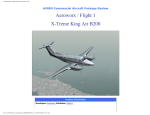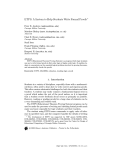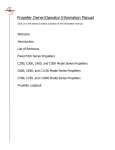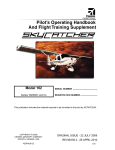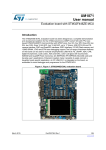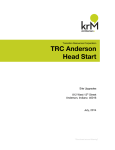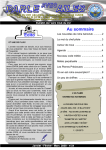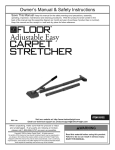Download approach - Flightline Aviation
Transcript
PROPELLE R Cessna Caravan owned by Tropic Air, headquartered in Belize IN THIS ISSUE: Aircraft Winterization Time Recording Piston Engine Information, Updates and More 2011 4 TH Q U A R T E R DIRECT approach in THIS Issue: WELCOME FROM CESSNA DAVE BRANT Senior Vice President Customer Service technical INFO 1 MESSAGE FROM DAVE BRANT 6 in every ISSUE 2 AIRCRAFT WINTERIZATION As the new person in CESSNA CUSTOMER Service, I wanted to introduce myself. To say it simply, I am a pilot and an airplane guy, just like many of you. 8 CUSTOMER SPOTLIGHT TROPIC AIR 16 PRODUCT SPOTLIGHT: 12 FATIGUE AND CORROSION TIME RECORDING spidertracks Global Tracking THE DIRECT APPROACH FOR PROPELLER IS PUBLISHED QUARTERLY BY THE CESSNA CUSTOMER SERVICE ORGANIZATION. COMMENTS AND SUGGESTIONS ARE WELCOMED. 19 ASK THE EXPERTS PLEASE ADDRESS YOUR COMMENTS TO MITZIE HALL 316-517-4237 [email protected] EDITOR: TOM RONNAU 316-517-1167 [email protected] And, after 37 years in aviation, I still look skyward when I hear an airplane fly over. I originally joined Cessna in 1974 and have worked in the aviation industry ever since. I have held several roles at Cessna, mainly in engineering. Most recently I was overseeing all of Cessna engineering as the Senior Vice President of Engineering. My engineering background and knowing how our Cessna airplanes are designed, has given me a great deal of insight into ways to better serve our customers. Cessna has a long and storied past beginning in 1927 with the production of the AW. An example of this airplane, restored by Cessna volunteers, is housed in one of our aircraft production hangars inspiring all by what was accomplished so long ago. From this austere beginning, a wealth of Cessna models have come to market. Each of those models has taken its place in the Cessna page 1 genealogy and has added to the rapid, ever changing knowledge that drives innovation. From the use of aluminum as the primary structure — replacing the steel tube, wood and fabric — to the installation of electrical systems and the glass cockpits with which we navigate today, Cessna has not stopped evolving. Cessna’s future is bright because of our continued commitment to integrate new technology into advanced integrated flight decks, the safety offered by TKS, and operating economics to be gained by our continued research into alternate fuels. Even while evolving our products, the support of our classic Cessna airplanes is a priority. Cessna continues to communicate the knowledge gathered through condition reports, and the vast experience of our Authorized Service network using service bulletins, maintenance manual revisions and supplemental inspections to address aging aircraft issues. Please take a few minutes and review the article in this issue about the supplemental inspection program. Developed for our classic single-engine airplanes the inspection is to confirm the structural integrity designed into the airplane so many years ago. At your next annual inspection ask your maintenance provider to incorporate the additional inspection tasks into the maintenance visit. Your safety is very important to us! Dave www.cessna.com CUSTOMER S PO T L I G H T a port, is the nation’s transportation, culture and economic hub. Tropic Air - FLYING HIGH WITH CARAVANS IN BEAUTIFUL BELIZE Down the coastal highway lies Dangriga, called the “cultural capital of Belize.” The area is home to Sittee River resorts, which draw divers and travelers hoping to observe the world’s largest fish species, the whale shark. The coast has some of the country’s best beaches, and visitors can travel inland to a preserve and try to spot the elusive jaguar. For Tropic Air, a domestic airline in Belize, something simple sealed its commitment to flying Cessna Caravans: Once the company started flying the 208B aircraft, it started making money. Steve Schulte, CEO and co-owner of the Central American airline, says he launched a personal campaign to get the Caravan after joining founder Johnny Greif III in the business in 1991. At the time, Tropic Air flew Twin Otters and had difficulty making money with the two-engine aircraft. Getting the airline’s first Caravan took until 1994 when a local businessman bought one and leased it to them. “That turned the tide as far as making money,” Schulte says. “It was immediately apparent that the Caravan was economical.” Caravan is Perfect Plane for Their Mission Tropical, tourist-attracting Belize is just 180 miles from tip to tip, nestled along the Caribbean between Mexico and Honduras. Tropic Air flights are nearly all short hops, with missions running about 12 minutes, and the airline averaging 5.3 cycles per hour. Most flights are to points dotted along the coast or on barrier-reef islands, as well as to the inland capital of Belmopan and to Flores, Guatemala. Outside of Flores and Philip S. W. Goldson International Airport serving Belize City, the strips it reaches are unimproved and just 3,000 to 6,000 feet long - a perfect environment for Caravans – Tropic Air flies nine, including two delivered in November. “We fly into some pretty rugged, poorly maintained runways,” Schulte says. page 2 A bit farther south is Placencia, on a peninsula with miles of sandy beaches, diving and snorkeling on the nearby reef. Placencia also is a habitat of the whale shark, and is the fastestgrowing resort community in Belize. Tropic Air’s southernmost destination is Punta Gorda, which has native Mayan villages and cultural and fishing resorts. Belize in the Caribbean between Mexico and Honduras. Steve Schulte, CEO and C0-Owner, Tropic Air. Two recent Caravans added to their fleet. “We needed its stall characteristics. The Caravan is about the only modern, stillin-production aircraft we can use.” The international flights streaming into Goldson provide a tight window of operation, as they all arrive between noon and 4:30. That means the airline, operating day VFR, must get passengers up and down the coast quickly before sunset. Up to five Caravans operate on some flights, with up to 200 daily missions. “One thing we didn’t realize at first was that the Caravan’s higher speed gave us more cycles to work with,” Schulte says. Tourists Come for Sea, Sand, Culture, Archaelogy For such a small country, Belize has incredible environmental diversity that draws sightseers from around the world. “Our business is up 20 percent this year,” Schulte says. “Belize has retained its natural beauty, and is a destination for environmentalists and people in love with the sea. We have the largest living barrier reef in the world, and the water is crystal clear.” Tourists can snorkel, sail, swim and fish in the blue waters off Ambergris Caye, the largest and northernmost of Belize’s 200 coastal islands, and its main town, San Pedro, is Tropic Air’s home. Caye Caulker, just south, is more laidback and less developed, a draw in itself, Schulte says. To the north along the border is Corozal, which draws tourists backpacking from Mexico and Belizeans taking day trips to shop in Chetumal, Mexico. Belize City, In addition to those stops, Tropic Air also flies to Flores, Guatemala, a launching point for visits to the immense Mayan ruins at Tikal. Except for a Cessna 172 used for charters and two Gippsland Airvans, passengers fly on Caravans, and like it. “Belize is a fairly new destination and is still drawing a lot of tourists who haven’t been to places where they have to fly in small planes,” Schulte says. “They say, ‘I never flew in a small airplane before but I’d rather fly in a small airplane than in a big one because I can see everything.’ ” Growing an Airline Schulte’s first trip to Belize convinced him to become a pilot. He’d gone through ground school when younger but hadn’t pursued his license until seeing the pilot of a Beech Baron become ill over the Gulf of Mexico. After that unsettling experience, he got his ticket back home in Moline, Ill. PLEA SE S EE NE X T PAG E page 3 Schulte ran a medical practice there but retired to Belize in 1990 – “and when I failed at that I got into the airline business.” A friend of the Greif family, he became co-owner in 1991 and found an airline quite like a medical practice. “It was very similar to managing doctors,” he says. “It’s a time-sensitive service and if that time passes and nobody’s in that seat, the income is lost forever. It’s a service-oriented business and a high-tech business. And you’ve got about the same liabilities.” The purchase of the airline’s next and subsequent Caravans came via Cessna Finance. “After we got the second Caravan, our two competitors chose not to buy Caravans. The Caravans were faster, more comfortable with better seats and nice windows to view the reef and sea.” “Within a matter of four or five years, as we added Caravans, our competitors shrank away.” On most flights Tropic Air uses one-man crews, carrying 14 passengers, including one in the co-pilot’s seat. “We’ve met a lot of Cessna pilots over the years. They say, ‘I’m a pilot, can I sit up front?’ We like to have fellow aviators in the right seat.” Flying in Belize poses its challenges. The frequent cycles ask a lot of any plane, of course. Then there are localized storms and the extremely high-salt environment, especially at its San Pedro base, where it does its maintenance. Schulte says they’ve been amazed at how well the corrosion-proofing works. Tropic Air is on its 16th and 17th Caravans, and currently operates nine. Recently it sold one with 50,000 cycles. “We don’t really see a specific useful life of the airplane. Our only decision for replacement is technological,” Schulte says. “You’re buying something that will last our lifetime and the only reason you’d want to replace it is to upgrade the technology.” For them, that new technology is the Garmin 1000 cockpit. Schulte and Greif are longtime converts to GPS – dropping out of the clouds on a charter flight, lined up with a mountainside, tree-lined airstrip will do that. The Garmin 1000 takes technology and safety to another level with Terrain Awareness and Synthetic Vision, the field is on the screen while you’re still in the clouds. The airline intends to extend its route into Honduras, to San Pedro Sula and Roatan, and would like to develop an inter-line agreement with La Costena, the Nicaraguan airline and Cessna dealer. “Our expertise is in the Caravan and in small, emerging markets, and I see a lot of growth potential for that, without penetrating the mountain chain of Central America,” Schulte says. And Tropic Air has just the equipment to serve its coastal niche. “We can attest that, at five cycles per hour, the Caravan is a nearly bulletproof airplane,” Schulte says. McCAULEY OVERHAUL INSPECTIONS Leaning Your Engine MINIMIZE FUEL CONSUMPTION Corvalis Operators FIXED PITCH PROPELLERS The majority of McCauley Fixed Pitch propellers have a recommended overhaul cycle of 72 calendar months or 2,000 hours, whichever comes first in accordance with procedures provided in the Fixed Pitch Service Manual. Please reference McCauley SB137(AE), Revised Time Between Overhaul and Life Limited Parts Inspections, for specific overhaul recommendations for all McCauley products. A copy may be obtained from McCauley Product Support or from the McCauley web site at www.mccauley.textron.com as well as a listing of McCauley Authorized Service Facilities. During the overhaul, the McCauley Authorized Service Center (or propeller repair station) will remove paint and coatings to facilitate careful inspection of the propeller. The propeller repair station will utilize both NDI and visual inspection processes for the blades and hub paying close attention to bolt holes for damage or cracks. They will then check the chord width and thickness at specific propeller blade stations and the face alignment to the dimensions provided in the service manual and importantly, agreement blade to blade. Upon completion of the inspection process and blade grinding to remove and blend damaged areas, they will apply alodine or anodize to the aluminum, followed by protective primer and paint and then carefully check blade track and propeller balance. If propeller mounting bolts are not replaced at overhaul they must be magnetic particle or dye penetrate inspected. MOUNTING TORQUE For Fuel Savings Leaning the engine for best fuel economy during normal ground operations is sometimes overlooked. Using this procedure, taken out of the appropriate Cessna Model Pilot’s Operating Handbook, can save money by minimizing fuel consumption and maintenance costs by preventing spark plug fouling. SB227(B) addresses propeller bolt mounting torque. The Fixed Pitch Propeller bolt torque is determined by the bolt diameter as given below. Always follow your aircraft maintenance manual practices if there are different values provided. In addition to an annual inspection of propeller bolt torque, each propeller blade should be inspected for stress risers, stone or other damage prior to flight. McCauley SB1995-4B addresses field repairs to propeller blades. Any “V” shaped notch in a leading edge should be considered a stress riser, and should be brought to the attention of a rated powerplant mechanic for evaluation and repair. After starting the engine, set the throttle to 1200 RPM and lean the mixture for maximum RPM. After leaning, set the throttle to the appropriate RPM for ground operations. Leave the mixture at this setting until beginning the BEFORE TAKEOFF checklist. After the BEFORE TAKEOFF checklist is complete, lean the mixture again, as described, until you are ready to perform the TAKEOFF checklist. Make sure to follow the mixture setting defined in the takeoff checklist for the airplane model. Get information or online quotes A list of stations can be obtained from the McCauley website at www.mccauley.textron.com. The McCauley Product Support group also provides technical support for all McCauley products, and can be reached at [email protected] or 800-621-7767. Fixed pitch propeller mounting bolts should be checked annually for proper torque, McCauley It’s easy to get Cessna Authorized Service Center information now Bolt or Nut Diameter Torque (DRY) Pound-Feet Pound-Inches 3/8 7/16 1/2 30 to 25 45 to 40 65 to 55 360 to 300 540 to 480 780 to 660 Need additional information or a quote? Let us know what it is, and we’ll immediately go to work and quickly contact you. It’s your connection to the quickest and best service in the business. page 4 Click here now. page 5 AIRCRAFT WINTERIZATION Batteries Batteries should be fully charged prior to storing the airplane. This includes the main and standby batteries. Consider removing the batteries from the airplane and storing them in a heated facility, if the airplane will remain inactive for the winter season. Corvalis Winter isOperators here and it’s time to get the airplane prepared for the cold days ahead. Wise pilots will also prepare themselves for winter operations as well as their planes. A review of the Icing section of the Pilot Safety and Warning Supplement, or for Caravan pilots, Cessna’s Winter Ops Seminars or Online Icing training will better prepare everyone for the weather to come: www.Cessnaelearning.com. Below are suggestions for keeping an airplane in tip-top shape through the winter months. Storing the Airplane for the Winter Preparation Wash the exterior and apply a high quality wax. This will protect the paint and helps prevent accumulation of snow and ice if stored outside. Survey all the items in the cabin. Check for articles or equipment that would not survive the frigid temperature of winter. Also look for water bottles or containers with liquids that could freeze and burst, leaving the airplane a mess when the temperatures warm back up. Storage Storing an airplane in a hangar is best. For airplanes that will be staying outside for the winter it is good to give some thought to the location the airplane will be moored. Things to consider are: • Prevailing winds - the airframe and flight controls will endure less stress from the winter winds if the airplane is parked into the wind. page 6 Fuel Tanks Fuel Tanks should be filled to full capacity to prevent condensation. Condensation is inevitable even with full tanks, so make sure the fuel system is properly drained and all water is removed before flight. • Snow drifts - park the airplane in an area that isn’t prone to them and is less likely to be plowed. • Snow plows on airport ramps - during snow removal, plows can move a lot of snow, so don’t let the airplane get buried. Mooring Ensure that the airplane is parked where there are dedicated anchors in the ground to tie the airplane down. It will be necessary to tie down at each wing, the tail and the nose gear. This serves the obvious purpose of keeping winds from upsetting the airplane. But tying the airplane down at the nose gear will assist in preventing the nose from coming off the ground, either from wind or snow accumulation. The parking brake should be disengaged and chocks installed in front of and behind the main wheels. If the airplane is going to be moored off of the concrete or asphalt ramp, put shoring materials like plywood under the tires to prevent them from sinking into soft ground and loosening the tie downs. Flight controls should have gust locks installed to prevent contact with the mechanical stops. Covers and Plugs All openings in the airplane should be plugged, covered or closed. This will prevent the accumulation of snow and ice in critical areas. Areas that should be considered are the engine cooling air inlets and cowl flaps. Also cover the Pitot tube, static ports, fresh air and heater inlets. Engine Engine oil should be drained and new oil installed. Old oil can be quite acidic, and when combined with water from the atmosphere causes corrosion. This can lead to pitting of components like cam lobes and bearing surfaces if the oil is left in the engine for an extended period of time. If the airplane is going to remain inactive and in storage for more than 30 days, consult the latest revision of Textron Lycoming Service Letter L180, which can be found on: www.lycoming.textron.com or SIL99-1 on www.TCMlink.com. Fuel As always, consider fuel contamination a concern, especially during cold weather operations. Ice could form in the tanks which would turn to water when the temperature rises, and may filter down the fuel system causing engine failure. In the cold temperatures, water can freeze in lines and filters, causing stoppage. Drain fuel frequently from the quick drains. If fuel does not drain freely from sumps, this could indicate a line or sump is obstructed by sediment or ice. Isopropyl alcohol or Diethylene Glyco Monomethyl Ether (DiEGME) may be added to the fuel supply to help alleviate the possibility of fuel icing. Section 8 of the Pilot’s Operating Handbook offers guidance on the quantities to use. For airplanes that remain active through the winter months consider the tips below during operation. Oil Besides being changed at regular intervals, consider using a lighter grade of oil, based on the Temperature Versus Viscosity Range table, in Section 8 of the Pilot’s Operating Handbook. Airframe and Control Surfaces It is mandatory that all frost, snow, and ice be removed before attempting flight. If the airplane is Engine Operation When air temperatures are below 20°F (-6°C), use an external preheater and an external power source when- Winter OPERATIONS PLEA S E S EE NE X T PAG E de-iced in a heated hangar, make sure the water does not run into the control surface hinges or crevices and freeze when the aircraft is taken outside. page 7 Cessna Sample Jar PN 0500838-1 ever possible, to obtain positive starting and to reduce wear and abuse to the engine and airplane’s electrical system. Preheat will lower the viscosity of the oil trapped in the oil cooler, which may be congealed prior to starting in extreme cold. If the engine does not start during the first few attempts, or if engine firing diminishes in strength, the spark plugs may be frosted over. Preheat must be used before another start is attempted. It should be noted that during cold weather operations, the oil temperature indicator may not be in the green band prior to takeoff. After a suitable warm up period (2 to 5 minutes at 1000 RPM), accelerate the engine several times to higher engine RPMs. If the engine accelerates smoothly and the oil pressure remains normal and steady, the airplane is ready for takeoff. www.cessna.com FATIQUE AND CORROSION COME WITH AGE INSPECTION PROGRAM WILL DETECT BOTH Cessna airplanes are built to last, which is why thousands are still flying decades after leaving the factory. But as 152s, Skyhawks, Skylanes, Stationairs, and other models get on in years, owners and operators must make sure that age hasn’t taken its toll. To help ensure that older planes remain in good, safe health, Cessna Aircraft has started a single-engine aircraft inspection program to check for corrosion and metal fatigue. The goal, of course, is catching any problems before they affect flightworthiness. Cessna built 145,000 single-engine planes between 1946 and 1986, with an average age of 42 years. Most fly 100 to 150 hours annually, and the FAA says about threequarters of the planes are operated for personal use. “Airplanes are getting older, and like anything that gets older, they need to be inspected more often,” says Beth Gamble, Cessna principal engineer, structures. “We are trying to give owners an indication of where cracks and corrosion have occurred and make them aware that they need to be looking at their airplane in the same areas.” Where an airplane is, or has been based, and how it’s been treated, can affect the likelihood and level of corrosion. Such factors include a coastal environment or a locale with higher air pollution, or if the aircraft hasn’t been hangared. “Owners really need to know where the plane has spent its life,” Gamble says. Just what is corrosion? Pure aluminum is highly corrosion resistant but not strong enough for structural use in aircraft. So, alloys are added for strength, but the downside is that the additives make the metal prone to corrosion. In addition, Gamble says, a video is being produced to educate owners, mechanics and inspectors on what to look for. “It’s a multipronged approach,” she says. “We’re trying to educate on all fronts, whether the owner or the maintainer.” The number of inspection sites varies by model, but usually involve 15 to 20 points, some of them covered by past service bulletins. The initial inspection is more intensive, establishing a baseline record for the plane, but follow-up ones will require less time. They are designed to be performed along with the plane’s annual. “On a low-time airplane the majority of the inspection is visual,” Gamble says. “They don’t need anything more than flashlight, borescope and magnifying glass. For a low-time, well-maintained airplane, inspections usually can be completed with the annual in less than 10 additional hours,” Gamble says. Higher-time aircraft are more susceptible to fatigue and will require some NDI techniques to assure structural integrity. To make these techniques available, Cessna is teaming with the National Center for Aviation Training in Wichita to hold classes in non-destructive inspection (NDI) specifically for its single engine models. When corrosion begins it is virtually undetectable by visual inspection, but it can soon spread and easily be detected by the eye – still at a point before safety is compromised. Treated, it can be removed relatively easily. Left alone, it can continue to eat away at the metal. The result can be holes and thinning and an acceleration of metal fatigue, resulting in cracking. Water and salt together make a powerful corrosive, which is why aircraft operating near saltwater can suffer corrosion faster. Industrial pollutants in the air also can speed the process. What’s an Owner to Do Owners should go over materials from Cessna and have their mechanic inspect the airplane accordingly. If corrosion is found, its depth should be evaluated and then it must be cleaned up. If damage is minimal and non-structural, a primer or other special sealant noted in the service manual should be applied to the affected area. corrosion Aircraft owners and maintainers can take steps to ward off corrosion by rinsing and cleaning their planes, especially exposed areas such as the landing gear, wheel wells and other joints and gaps where debris collects. If paint chips, repair it promptly. And if hangaring is not possible, keep your plane covered and sheltered during wet or severe weather. PLEA SE S EE NE X T PAGE Just What is Corrosion? Cracks in spar web The Inspection Program The new structural inspection program is already under way. Service manuals for 200 series aircraft were updated in early December, detailing inspection points and setting schedules. Updates for 100 series aircraft are expected to publish in the second quarter of 2012. These revisions can be found at Cessnasupport.com behind the customer access link on the model specific pages. As new revisions are released they will be published on the web in PDF format. page 8 corrosion If damage is more severe, parts may need to be replaced. Areas affected by corrosion and fatigue vary by aircraft, but common ones are landing gear, strut braced wings, airframe ribs and cantilever wing attach points. Because they are subjected to thermal cycles and weather-related water leaks, the cabins also are susceptible, as upholstery can absorb and retain moisture. page 9 “The fact is that corrosion and metal fatigue are going to happen,” Gamble says. “Airplanes are going to age, like people do, and you have to do things to maintain the safety of them.” Adopting the recommendations contained in the supplemental inspections are the actions necessary to maintain an aging airplane. www.cessna.com Customer Access Page CessnaSupport.com Website Gets More Personalized Cessna Gifts Fly Over to the Cessna Online Gift Shop For A Cargo-Hold Full of Gear For that special pilot or aviation ENTHUSIAST in your life There are new enhancements to the Customer Access page on CessnaSupport.com, making the website more personalized and user-friendly. Gifts that say Cessna are a safe bet to make a sure landing under the tree at Christmas or for birthdays or other occasions. The Cessna Online Gift Shop, www.cessnagiftshop.com, offers a wide range of items with the Cessna logo, whether as a gift or just something you need to look sporty or flight-worthy. The site has clothing for men, women and kids; duffels, and other luggage; coffee mugs and travel cups; pens, notepads and workplace gear; models of single engines and jets; and plenty of pilots’ gear. MY INFORMATION BOX Is your contact info accurate? You will notice a new My Information box in the upper left corner of the homepage. The new addition offers a My Aircraft Info link that directly ties you to your subscription information, serialized service document search listing, serialized flight documents and current contact information. Social Media buttons are also provided for Cessna’s Twitter, Facebook, and YouTube sites. For the My Contact Information box, you can make sure your personal contact information is accurate for Cessna to contact you for any issues related to your aircraft. For the serialized documents, you can instantly access the Flight Manual Temporary Changes or Supplements, Emergency and Normal Procedures Checklists. This function also includes a serialized service documents search report applicable to your specific aircraft. page 10 Operators of legacy and production Citations and Propeller aircraft alike will benefit from the Aircraft Publications page, which provides a search engine for all service bulletins and letters including service kits and Instructions for Continued Airworthiness (ICA) documents. Questions, please contact: Cessna Customer Care 316-517-5800 or 1-800-423-7762 [email protected] And whether you are a hacker or an able golfer, the store offers plenty of options, from bags and towels to logoed golf balls that are easy to find in the rough. Happy shopping! Cessna Gift Shop 316-517-GIFT (4438) www.cessnagiftshop.com Custom merchandise with Cessna model logos can be ordered. Clothing options for men and women are many, including classic and lightweight sport polos, oxford shirts, T-shirts of many kinds and colors, fleece and flight jackets, sweaters and other outerwear. Little ones can get an early start on the Cessna tradition, too, including one-sies, baby sweaters, toddler tees, teddy bears and coloring books. Own a Stationair or Caravan and need a matching ball cap or lapel pin? The Gift Shop has a variety of single-engine and jet model hats and lapel pins. They also offer high-quality replicas of many Cessna aircraft in different sizes, each with a base that makes it easy to display on a desktop or bookshelf. page 11 www.cessna.com TIME RECORDING Defined in the code of federal regulations title 14 Part 1, Section 1.1: The Caravan also uses an hour meter for maintenance time records. The hour meter is wired to the clock circuit breaker, and is activated by an airspeed switch. FLIGHT TIME Flight time, means pilot time that commences when an aircraft moves under its own power for the purpose of flight and ends when the aircraft comes to rest after landing. TIME IN SERVICE Time in service, with respect to maintenance time records, means the time from the moment an aircraft leaves the surface of the earth until it touches it at the next point of landing. mechanical hour meter. In order for the instrument to record hours, the master switch must be “ON” and the engine oil pressure must be at a sufficient level to activate the oil pressure switch. Cessna piston twin aircraft uses an hour meter wired through a weight on wheels switch, often referred to as a squat switch, to record time in service. The digital hour meter The Cessna 162 Skycatcher records flight time when the engine is operated above 600 RPM. Flight time is displayed as TOTAL HRS on the Engine page of the G300 primary flight display. Time in service Electronic recording tachometers installed in all models of the G1000 and G300 equipped Cessna airplanes display the calibrated time as engine hours. Engine hours are accumulated whenever a valid RPM signal is present. Similar to a mechanical recording tachometer, the rate at which engine hours are accumulated is directly proportional to engine RPM. The ratio of engine hours to time is 1:1 at normal cruise RPM and 0:1 at 0 RPM. FLIGHT TIME The mechanical hour meter The mechanical hour meter (Commonly referred to as a Hobbs Meter) An hour meter records time when an electric circuit is present. While power and ground are applied to the instrument, a small electromagnet winds a spring that powers the clock every few seconds. When an aircraft equipped with an hour meter is shut down, the clock can sometimes be heard making its last few ticks, ready to be wound next time power is applied. Current production 172, 182, 206 and the majority of Cessna out of production single engine aircraft use an oil pressure switch to power the 12 page The mechanical recording tachometers typically installed in single engine Cessna airplanes are calibrated for the cruise RPM of the installation. The tachometer calculates time in service by mechanically dividing the accumulated number of engine revolutions by the cruise revolutions per hour for which it is calibrated. Therefore, it will record one hour of operation if the engine is operated for one hour at the calibrated cruise RPM. However, if the engine is operated at 75% of the calibrated cruise RPM for one hour, the instrument will record 45 minutes of operation. The hour meter is not used exclusively for flight time. The Cessna Corvalis uses an hour meter to record time in service. The Avidyneequipped Corvalis must have an indicated airspeed of approximately 60 knots to activate an air speed switch to complete the hour meter circuit. The Garmin-equipped Corvalis added an oil pressure switch to the airspeed switch circuit which powers the hour meter. The addition prevents inadvertent operation of the hour meter when the airplane is tied down during extremely windy conditions. G1000 panel in a 172 Cessna Skyhawk PLEA S E S EE NE X T PAGE 13 page So, flight time, used to qualify for certificates and calculate insurance premiums, is based on the time the pilot spends operating the aircraft, and includes flight and ground operations. Typically aircraft rental rates are also based on flight time. Some Cessna propeller aircraft include, as a convenience to the pilot or rental operator, a method to record and display flight time. Maintenance is based on only the time the aircraft is airborne and is referred to as time in service. All Cessna propeller aircraft are equipped with a means to record and display time in service. TASK BASE MAINTENANCE PROGRAM For the Caravan Revision 24 of the Caravan Maintenance Manual which published in June of 2011, includes the new task based maintenance program which was created using the MSG3 methodology. In July of this year Cessna published Service Bulletin CAB11-5 which provides the instructions necessary to incorporate the new task base maintenance program into your operation. Please refer to the service bulletin for all the details including copies of chapter 5 Revision 23. Questions, please contact: Cessna Customer Care 316-517-5800 or 1-800-423-7762 [email protected] The new program replaces all of the current recommended maintenance programs offered by Cessna including the Phase Card program. Cessna will no longer support, revise or provide subscriptions to the previous inspection programs. The new program has the following enhancements: • The majority of task intervals were extended to 400 hours. • The landing gear disassemble inspections were incorporated in a task due every 4 years for all kinds of operations. • The Corrosion Prevention & Control Program inspections were incorporated into the chapter five inspection tasks. • Supplemental Inspection Documents were also incorporated into the chapter five inspection tasks. • Inspection items deemed redundant, unnecessary or speculative were deleted. The switch over of maintenance programs is as easy as performing Inspection Document 5-15-0A at your next annual inspection, or the end of your Phase Card, or Progressive operations cycle. Inspection Document 5-15-0A is the inspection package to use when complying with 14 CFR 91.409. It is not a standalone document and must be used as part of the total maintenance program. Every 12 calendar months, Inspection Document 5-15-0A must be accomplished as the annual inspection. Customers operating for hire under 14 CFR 91 are required to perform the same inspection every 100 hours. CLEANING KIT There’s a clean, shiny aircraft in every Cessna Cleaning Kit bag. Specially formulated to preserve leather, surfaces, and even windows, The Cessna cleaning kit puts six cleaners, spot removers, and waxes in one easy bag. Or, purchase separately for specific needs. Revision 24 of the Caravan maintenance manual satisfies 14 CFR 43 Appendix D as follows: • Inspection Document 5-15-0A inspects the applicable items identified during the MSG-3 process and will verify all remaining inspections are current. • 14 CFR 43 Appendix D clearly indicates “where applicable” on each of the inspection items. Cessna’s review indicated that not all items are applicable at each annual, or where the annual is accomplished every 100 hours, based on customer operation. For more information or to order, please call your Cessna Authorized Service Facility. To locate the one nearest you, call 866-777-6150 or 316-261-8063 (international). PLEA SE S EE NE X T PAG E 14 page One Easy Bag to Baby Your Baby 15 page product spotlight spidertracks: preferred by pilots around the world All around the world pilots are recognizing the safety and social benefits of spidertracks aircraft tracking technology. Caravan Boot “Operationally we use it all the time to follow where our aircraft is and how progress is being made on any particular flight. - Murray Paterson, New Zealand “I think having spidertracks on board and having the ability to flight-follow on the Internet, especially when operating into areas where there is no radio coverage, and to know your family can see when you have landed safely is worth while.” spidertracks, the global aircraft tracking provider to fleet operators and private pilots, is recognized as the best dedicated aircraft tracking system because of its simplicity, low cost and reliability. According to Jim Herd from Nevada, spidertracks has two very important benefits, and with no serious competitors. “It is vastly better than any ELT for calling help when it is urgently needed, because it doesn’t need to survive the crash, and because it is confirmed to be working correctly every time you fly. It also provides fantastic social benefit with near-real-time precise and detailed tracking on a website, so friends and family can follow along as each flight progresses. In fact, it is the ‘loved ones’ on the ground that enjoy the greatest benefit!” PARTNER IN SAFETY Up in Alaska, Stewart Barnes says, “spidertracks is an important partner in my flying safety and a welcome assistant in communicating my activity and locations to the people I trust. If I have a problem out in the Alaskan bush, somebody will know about it and will dispatch help. I’m very pleased to have that safety tool at my disposal. I highly recommend spidertracks to all pilots who venture off the beaten path.” Murray Paterson from New Zealand has his spider hard-wired into his Cessna 180. “I am a firm believer that spidertracks is a valuable tool to aid any future recovery if we happen to have issues while flying around New Zealand. To give yourself and passengers a better chance of being pinpointed very quickly in an emergency then it’s got to be a great investment. PLEA SE S EE NE X T PAG E page 16 The spider ST 003 has been specifically designed for use in light aircraft. It is just $995 and is portable, so can be moved between aircraft or hard-wired into the aircraft. With a view of the satellites, it will transmit the aircraft’s position every two minutes, including altitude as well as position and speed, reliably to the spidertracks website - where it has laid down a breadcrumb trail. Family and friends can follow the flight in real-time, knowing where the pilot is as at any time. When in “Watch” mode, the system will automatically send out SOS alerts as soon as help is needed, so search and rescue can be directed quickly to the aircraft’s location, possibly saving lives. Ongoing costs start at as little as $2 per flying hour, making this life saving technology affordable to all. spidertracks transmitting aircraft’s real-time position, viewable on their web site. Above: Stewart Barnes, Alaska Right: Murray Paterson’s Cessna 180, New Zealand For more information or to order, please call your Cessna Authorized Service Facility. To locate the one nearest you, call 866-777-6150 or 316-261-8063 (international). 17 page www.cessna.com Cracking of the Cosmetic Filler Surrounding the Windshield and Windows (Update) Corvalis ask THE EXPERTS EXPERTS FROM THE CESSNA SUPPORT TEAM SHARE ADVICE AND SHED LIGHT UNIQUE CONFIGURATION To achieve an aerodynamically smooth and aesthetically pleasing installation, the windshield and windows on the Corvalis are installed in a unique configuration during the manufacturing process. The transparency is bonded into a recess in the fuselage structure, and the installation is smoothed with body filler, then the area including the portion of the transparency that overlays the fuselage structure is painted. BODY FILLER Occasionally, the body filler in this area can experience hairline cracks. Cracks that are isolated to the body filler in this area are not a structural concern. In June 2006, SL-06-12 was issued to repair these cracks. Aircraft repaired in accordance with SL-06-12 subsequently cracked in the repaired areas. In an effort to ensure the proper techniques were used during the repair, Cessna superseded SL-06-12 with SB08-56-01, which was essentially I own a Corvalis with G1000, SB11-34-03 has been complied with. While reviewing the data logged on my SD card, which data is associated with the left alternator? Answer On the Corvalis, in the .csv files saved by the G1000 on the SD card: • volt1 and amp1 refer to the left bus • volt2 and amp2 refer to the right bus This is opposite the alternator numbering scheme used in the aircraft maintenance manual. the same repair, but contained more detailed instructions. Aircraft repaired in accordance with SB0856-01 subsequently cracked in the repaired areas. In February 2009, further compliance with this bulletin was suspended until a more robust repair could be identified. cONTINUE TO INVESTIGATE Cessna has continued to investigate alternate repair schemes, and to date, Cessna has tested three different configurations. Constructing three samples of each configuration, each was tested in an environmental chamber by cycling the air temperature in the chamber from -45°F to 175°F with a 30 minute hold at each temperature. All configurations tested suffered one or more cracks in the environmental chamber. Cessna also inspected three aircraft previously repaired with a fiberglass overlay across the area prone to cracking, and found two of these aircraft had cracks reoccur in the repaired area. Although we have not arrived at a configuration that will provide the required longevity, we do continue our investigation to identify a robust repair. How To submit comments and ask THE EXPERTS THE DIRECT APPROACH IS EMAILED QUARTERLY BY THE CESSNA CUSTOMER SERVICE ORGANIZATION. CROSS-SECTION OF WINDOW INSTALLATION Filler & Paint ANSWERS ASK THE EXPERTS AT: [email protected] And put Ask An Expert in the subject line Area susceptible to hairline cracks Cessna hopes to make this a regular feature of this newsletter, but needs help to make it worthy. So if a question has been nagging or you just thought of something that others might be interested in, please Ask An Expert. Cessna experts will do their best to answer all submissions. If the responses do not appear here, an answer will be sent by email. THANKS for taking time to read our publication! Window page 18 Adhesive Structure We appreciate your readership and will do our best to continue to present you with the latest piston related news, products & happenings throughout the year. 19 page www.cessna.com












